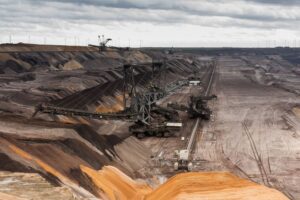Amazon (NDQ:AMZN) is a great company, but will it escape an impact from Trump’s tariffs?
![]() Nick Sundich, May 20, 2025
Nick Sundich, May 20, 2025
Amazon (NDQ:AMZN) … the Everything Store. That was the title of journalist Brad Stone’s biography of the company as well as an accurate description of what the Magnificent Seven company does.
There’s little not to like about the company. The dominant market position in existing markets, the ability (the employee brains and capital) to go after new market opportunities and the loyalty of its customers. As Seattle’s Great White Shark approaches its 30th birthday, it isn’t necessarily the easiest time in its history. And yet, it has grown 72% in the last year, and its recent annual results were warmly received by investors. But not for the reasons you may think.
Who is Amazon (NDQ:AMZN)?
The Everything Store essentially. It began as an online intermediary between book readers and wholesalers. Founder Jeff Bezos quit his job working for a New York hedge fund and moved across to Seattle to capitalise on the growth of the Internet.
As the years went on it expanded into more and more products and services, delivering them faster and faster to customers as well as expanding outside North America. We think two should be singled out.
First, its membership service Amazon Prime which boasts over 200 million members around the world (a figure twice as high as 5 years ago). There is so much you get for it – expedited delivery (without delivery fees), Prime Video, Prime Music and exclusive access to deals (particularly on Amazon’s annual Prime Day).
Second is Amazon Web Services (AWS), offering Cloud computing services to individuals, companies and governments. This division began as just another idea in 2006, but demand for it exploded during the pandemic. With everyone working from home, you don’t want all your data just sitting on one computer somewhere that is only accessible in person. It now accounts for over $100bn on annualised revenue and over two-thirds of operating income.
Bezos stood down in 2021 and was replaced by CEO Andy Jassy. He’s no newcomer, having been with the company since 1997 and playing a key role in the establishment of AWS.
A journey of growth (but not exclusively)
It has not always been easy for Amazon. The company survived the Dot com bust, yes, but it was a fight for profitability.
You could argue it wouldn’t have survived had existing retailers done anything at all to compete (other than tell themselves Amazon was just ‘1, 2, 3, 4, 5%…’) before it was too late.
Not all of its expansion efforts have been overnight success stories, or even successes at all. Its efforts to enter physical stores have generated some fruit (but with only US$20bn in revenue annually, they’re an afterthought in the context of the entire group).
Yet even as it reached profitability, margins have remained wafer-thin, leaving investors concerned amidst the Tech Wreck. However, these concerns were quickly cast aside by investors. In 2024, it made US$638bn in sales, up 11%, and it made a US$59.2bn profit (or $5.53 per diluted share) with the latter being nearly double the year before.
Its achievements included delivering at the fastest speeds for its Prime members and delivering 65% more items to Prime Members (in the US) the same day or overnight than a year ago. Plus, it rolled out tonnes of new AWS capabilities, led by a family of foundational language models (Amazon Nova).
Amazon is excited about AI
Andy Jassy has continued Bezos’ tradition of writing shareholder letters which also include the first ever letter (from 1997) and ending it with the proclamation that ‘It remains Day One’. Bezos once said it would never be Day 2 because Day 2 would be decline.
The letter concluded with these words,’ We operate like the world’s largest startup in large part because of our culture of Why. We don’t always get everything right, and we learn and iterate like crazy’. ‘But we’re constantly choosing to prioritise customers, delivery, invention, ownership, speed, scrappiness, curiosity, and builder a company that outlasts us all. It remains day one’.
The bulk of the letter spoke about that culture of Why and it addressed the question of why AI was important. Jassy proclaimed that AI would,’ reinvent virtually every customer experience we know, and enable altogether new ones about which we’ve only fantasised. …It’s moving faster than almost anything technology has ever seen’.
One of the key things Amazon is doing is building its own chips – the Trainium2 chips, that don’t just offer better performance but price-effective performance. Jassy also said that there were over 1,000 GenAI applications being built.
Trump’s tariffs
The company didn’t give full-year guidance, but guided to US$151-155.5 for the first quarter of the year – up 5-9% from Q1 of 2024 and this was even with unusually large and unfavourable forex impacts. Its operating income was forecast to be $14-18bn compared to $15.3bn.
Ultimately, the company overdelivered with these figures being $155.7bn and $18.4bn respectively. It guided to $159-164bn net sales in Q2 (7-11% higher) and $13-17.5bn operating income.
Of course, the elephant in the room is Trump’s tariffs. There’s no sugarcoating this – Amazon will be impacted. The company has seen some short-term evidence of shoppers buying ahead in anticipation of price hikes, because these are seen as inevitable by those consumers and by Andy Jassy too.
Amazon had begun to cancel some direct import orders on liberation day, only for the tariffs to be postponed. It was reported that Amazon was planning to inform customers just how much tariffs would cost them, and the company was publicly rebuked by Karoline Leavitt. Privately, President Trump personally called Jeff Bezos to complain. Another twist in the pair’s complicated relationship. Amazon later clarified this plan was ‘never approved’ and was ‘not going to happen’.
Early last week, Amazon shares rallied upon news tariffs on ‘de minimis’ Chinese goods (i.e. shipments under US$800) would go down from 120% to 54%.
What is it worth now?
Analysts covering Amazon have a target price of $237.56, a ~16% premium to the current share price. This is drawn from 65 analysts across Wall Street. We think Amazon is worth US$242.32 per share, using consensus estimates and an 8% WACC. Analysts expect US$695bn in revenue and $6.20 EPS for CY25. For CY26, $762.1bn in revenue and $7.27 in EPS. For CY27, $836.9bn in revenue and $8.95 EPS.
For those wondering, the company is expected to hit US$1tn in revenue in 2030. Its multiples are 33.1x P/E for CY25 and 28.3x for CY26. Its PEG multiples are 1.7x and 1.5x respectively. Not cheap, but cheap for a company of Amazon’s spectrum. It is US$1tn behind Apple, Microsoft and Nvidia for comparison’s sake. And yet here is a company growing at 10%+ every year, going after competitors like befuddled pray.
How it compares to Walmart
Let’s turn our attention to Walmart, a company commonly compared to Amazon and arguably its best rival. After all Amazon’s founder who got richest from selling stuff in the 21st century, while Walmart founded by the man who got richest from selling stuff in the 20th century. Walmart lost Round 1 to Amazon, but it is not out of the game yet.
Walmart remains the world’s largest company by revenue and it is challenging Amazon in the eCommerce field. Its eCommerce sales are 13% of its sales and they have continued to grow over 10% post-pandemic even though many other eCommerce company revenues fell.
Walmart has several advantages over Amazon including its logistics and store networks, its cash reserves, the fact that it is a ‘one stop shop’ as well as the mix of goods, both essentials that are purchased regularly and bigger ticket items purchased less frequently but are higher margin for the company.
Another way in which Walmart is competing with Amazon is with its Walmart+ membership program. For US$98 per annum (or $13 monthly), you get benefits including free delivery, early access to Black Friday sales, fuel savings and a Paramount+ Essential Plan. Yet another innovation Walmart is working on is having EV chargers at its stores. It already has 1,300 fast-charging stations and plans to keep expanding the network.
At the same time, the one thing Amazon has that Walmart doesn’t is AWS and that will be a key driver of growth going forward. It is easy to overlook that Amazon uses AWS for its own purposes, and that is very convenient for it. Obviously the revenue comes in from companies that opt to use it, but the operational advantage cannot be overlooked.
Conclusion
Amazon is one of the best companies out there and has a bright future ahead of it. However, those who think it is the growth of eCommerce aren’t looking hard enough at the company. The catalyst for growth is its profitability, that is only expected to get bigger, and growth from AWS that shows no signs of slowing down. Trump’s tariffs may have an impact, but unlikely to the extent that growth would slow enough for the company’s reputation to be hit (at least in the long-run).
What are the Best ASX Stocks to invest in right now?
Check our buy/sell tips
Blog Categories
Get Our Top 5 ASX Stocks for FY26
Recent Posts
Webjet Sinks 22 Percent After Softer H1 Results and Weak Domestic Demand
Webjet Falls 22 Percent After H1 Revenue Dips and Domestic Flight Demand Softens Webjet (ASX: WJL) opened down 22 percent…
Javelin Minerals Jumps 2,900 Percent on Capital Consolidation
A Sharper Share Register Sets Javelin Minerals Up for Its Next Corporate Stage Javelin Minerals (ASX: JAV) surged an extraordinary…
Why Are Droneshield Shares Dropping and Should You Be Worried
DroneShield Selloff Tests Nerves, But Fundamentals Tell a Different Story DroneShield (ASX: DRO) experienced a sharp selloff this morning that…



